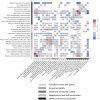Social Risk Groups in Patients With Diabetes With Differing Eye Care Utilization and Vision Outcomes
- PMID: 38497518
- PMCID: PMC10950035
- DOI: 10.1167/tvst.13.3.13
Social Risk Groups in Patients With Diabetes With Differing Eye Care Utilization and Vision Outcomes
Abstract
Purpose: To evaluate whether latent class analysis on social determinants of health (SDoH) data can identify social risk groups that differ by adverse SDoH and vision outcomes in patients with diabetes.
Methods: This was a prospective cohort study of adults ≥18 years with diabetes who completed a SDoH survey. Latent class analysis was used to cluster patients into social risk groups. The association of social risk group and severity of diabetic retinopathy, history of lapses in diabetic retinopathy care, and visual acuity was evaluated.
Results: A total of 1006 participants were included. The three social risk groups differed by sociodemographic characteristics. The average age was 65, 60, and 54 in Groups 1, 2, and 3 respectively. Most (51%) patients in group 1 were non-Hispanic White, 66% in group 2 were non-Hispanic Black, and 80% in group 3 were Hispanic. Group 1 had the lowest burden of adverse SDoH per person (average 3.6), group 2 had 8.2, and group 3 had 10.5. In general, group 1 lacked diabetic retinopathy knowledge, group 2 had financial insecurity and difficulties with transportation, and group 3 had financial insecurity and did not have health insurance. Social risk group was associated with a history of lapses in diabetic retinopathy care, and presenting with worse vision.
Conclusions and translational relevance: We identified distinct social risk groups among patients seeking care for diabetic retinopathy that differed by social needs, eye care utilization, and vision. Identifying these groups and their specific needs can help guide interventions to effectively address adverse SDoH and improve eye care utilization and vision outcomes among patients with diabetes.
Conflict of interest statement
Disclosure:
Figures


Similar articles
-
The Impact of Social Determinants of Health on Eye Care Utilization in a National Sample of People with Diabetes.Ophthalmology. 2023 Oct;130(10):1037-1045. doi: 10.1016/j.ophtha.2023.06.007. Epub 2023 Jun 15. Ophthalmology. 2023. PMID: 37329902 Free PMC article.
-
Social determinants of health impacting adherence to diabetic retinopathy examinations.BMJ Open Diabetes Res Care. 2021 Sep;9(1):e002374. doi: 10.1136/bmjdrc-2021-002374. BMJ Open Diabetes Res Care. 2021. PMID: 34583972 Free PMC article.
-
Vision related quality of life in patients with type 2 diabetes in the EUROCONDOR trial.Endocrine. 2017 Jul;57(1):83-88. doi: 10.1007/s12020-016-1097-0. Epub 2016 Sep 14. Endocrine. 2017. PMID: 27628581 Clinical Trial.
-
Screening for and managing diabetic retinopathy: current approaches.Am J Health Syst Pharm. 2007 Sep 1;64(17 Suppl 12):S8-14. doi: 10.2146/ajhp070331. Am J Health Syst Pharm. 2007. PMID: 17720893 Review.
-
Prognostic factors for the development and progression of proliferative diabetic retinopathy in people with diabetic retinopathy.Cochrane Database Syst Rev. 2023 Feb 22;2(2):CD013775. doi: 10.1002/14651858.CD013775.pub2. Cochrane Database Syst Rev. 2023. PMID: 36815723 Free PMC article. Review.
References
-
- World Health Organization. A conceptual framework for action on the social determinants of health. Available at: https://www.who.int/sdhconference/resources/Conceptualframeworkforaction.... Accessed January 1, 2023.
-
- Nwanyanwu KH, Andoh J, Chen E, Xu Y, Deng Y.. Social determinants of health in diabetic retinopathy in the US: evidence from the National Health and Nutrition Examination Survey (2005-2008). Invest Ophthalmol Vis Sci. 2021; 62: 1135.
MeSH terms
Grants and funding
LinkOut - more resources
Full Text Sources
Medical

